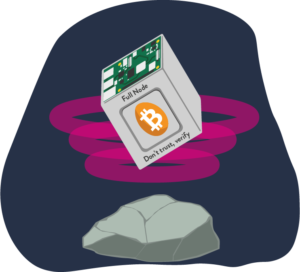Nodes
You bunch of curious rabbits, you made it ! The Bitcoin Node theme page. It is a key aspect of Bitcoin, one that can be as complex as simple. We’ll try to answer all your questions with the appropriate resources so you can become Bitcoin.

What is a node?
A node is running the Bitcoin Core software. It does not mine and does not provide any monetary returns. There are Bitcoin nodes and Lightning Network (LN) nodes. For this kind of node, please have a look at the Lightning Network theme page.
What is a node for?
You run a node to be part of the Bitcoin network. Thus, you contribute to the network decentralization, you also enforce the consensus rules. It allows you to send and receive transactions through that network (communicate with other peers) and have a copy of the whole ledger (history of all past transactions).
Therefore, a node is an essential tool to fully take advantage of Bitcoin and ensure the reliability of the network.
Who should run a node?
Short answer is probably everyone. But to be a bit more realistic, answer is : merchants or businesses who need to receive a lot of transactions. Individuals who care about their privacy. Plebs who do not trust but verify. Wealthy people with lots of bitcoins, regulators, exchanges, miners, tech-savvy tinkerers…
What does a node look like and how much does it cost?
A node is only software and a database (around 475Gb as of July 2022). So, you too can get a node on your computer (like Bitcoin Core). You can host it in the cloud with services like Lunanode, AWS or OVH. All in all, the best answer for individuals is an external case sitting next to your router or modem, for instance a Raspberry Pi 4 running a dedicated solution like Umbrel.
The cost of a node ranges from €0 (Bitcoin Core on your computer) to €12/month for a cloud solution, to like €200-300 + €5/year in energy for a home hosted RPi solution.
If needed, here is the bill of materials for an Umbrel node (our course number 2 – https://academie.decouvrebitcoin.fr/)
You can find the setup tutorial right here.
What can I do with a node?
A node gives you control over the Bitcoin network, so you can access your node’s mempool (the transactions waiting for validation) or its own offline block explorer (you can check transactions without having to trust a third-party or leaving a trail). You’ll want to connect your wallet (software or hardware) to it, like your Trezor or Blue Wallet for instance. This way, it’s your own little server which verifies that what you are spending or receiving are actually real bitcoins. Lastly, you are able to vote on the various forks that could happen (hard or soft) through the consensus you’re running.
If you need a security summary, you’ll find it here.
Once again, LN nodes are different.
For more resources, you can check those videos :
- https://youtu.be/shi1L7gNDVQ
- https://youtu.be/QXEVEOW6i9E
- https://youtu.be/K3sMkVbenUo
- https://youtu.be/C2da4NiMPF0
- https://youtu.be/qe4pT8ok-tY
- https://youtu.be/1jcM4Bp79KU
- https://youtu.be/y4ysUro7WtI
Nodes are the biggest difference when comparing Bitcoin to the other projects : they are easy, accessible and low-cost for the masses. On our Discord server, we have a dedicated chat room about nodes if you ever need.
I’ll repeat myself here: a Bitcoin node does not earn any money, there is no stacking, no airdrops or no mining. It’s an additional tool to your wallet in order to become more sovereign. If you’re looking to run a Lightning node, consisting in locking satoshis on liquidity channels, then it’s different.
Can you mine with a node?
NO, but every miner needs a node to communicate with the network, get the incoming transactions, confirm them, build and propagate the blocks.
Review : nodes are the central element of Bitcoin, they run the network and are the keepers of the consensus. Without nodes, there would be no decentralization.
Run a node, become Bitcoin.
Thank you
